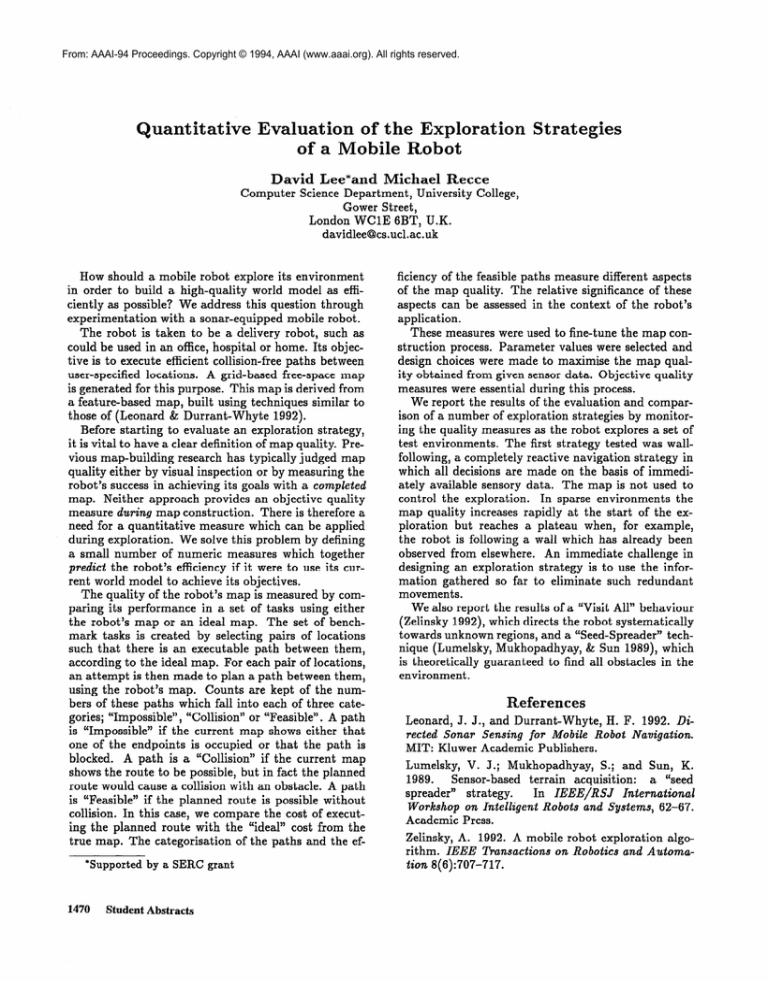
From: AAAI-94 Proceedings. Copyright © 1994, AAAI (www.aaai.org). All rights reserved.
Quantitative
Evaluation of the Exploration Strategies
of a Mobile Robot
David Lee*and Michael
Computer
Science
How should a mobile robot explore its environment
in order to build a high-quality
world model as efficiently as possible? We address this question through
experimentation
with a sonar-equipped
mobile robot.
The robot is taken to be a delivery robot, such as
could be used in an office, hospital or home. Its objective is to execute efficient collision-free paths between
user-specified
locations.
A grid-based free-space map
is generated for this purpose. This map is derived from
a feature-based
map, built using techniques similar to
those of (Leonard & Durrant-Whyte
1992).
Before starting to evaluate an exploration
strategy,
it is vital to have a clear definition of map quality. Previous map-building
research has typically judged map
quality either by visual inspection or by measuring the
robot’s success in achieving its goals with a completed
map. Neither approach provides an objective quality
measure during map construction.
There is therefore a
need for a quantitative
measure which can be applied
during exploration.
We solve this problem by defining
a small number of numeric measures which together
predict the robot’s efficiency if it were to use its current world model to achieve its objectives.
The quality of the robot’s map is measured by comparing its performance
in a set of tasks using either
the robot’s map or an ideal map. The set of benchmark tasks is created by selecting pairs of locations
such that there is an executable
path between them,
according to the ideal map. For each pair of locations,
an attempt is then made to plan a path between them,
using the robot’s map. Counts are kept of the numbers of these paths which fall into each of three categories; “Impossible”,
“Collision” or “Feasible”. A path
is “Impossible”
if the current map shows either that
one of the endpoints is occupied or that the path is
blocked.
A path is a “Collision” if the current map
shows the route to be possible, but in fact the planned
route would cause a collision with an obstacle. A path
is “Feasible” if the planned route is possible without
collision. In this case, we compare the cost of executing the planned route with the Ydeal” cost from the
true map. The categorisation
of the paths and the ef*Supported by a SERC grant
1470
Student Abstracts
Recce
Department,
University
Cower Street,
London WClE 6BT, U.K.
davidleeQcs.ucl.ac.uk
College,
ficiency of the feasible paths measure different aspects
of the map quality. The relative significance of these
aspects can be assessed in the context of the robot’s
application.
These measures were used to fine-tune the map construction process. Parameter values were selected and
design choices were made to maximise the map quality obtained from given sensor data. Objective quality
measures were essential during this process.
We report the results of the evaluation and comparison of a number of exploration strategies by monitoring the quality measures as the robot explores a set of
test environments.
The first strategy tested was wallfollowing, a completely reactive navigation strategy in
which all decisions are made on the basis of immediately available sensory data. The map is not used to
control the exploration.
In sparse environments
the
map quality increases rapidly at the start of the exploration but reaches a plateau when, for example,
the robot is following a wall which has already been
observed from elsewhere.
An immediate challenge in
designing an exploration
strategy is to use the information gathered so far to eliminate such redundant
movements.
We also report the results of a “Visit All” behaviour
(Zelinsky 1992)’ which directs the robot systematically
towards unknown regions, and a “Seed-Spreader”
technique (Lumelsky, Mukhopadhyay,
& Sun 1989)’ which
is theoretically
guaranteed to find all obstacles in the
environment.
References
Leonard, J. J., and Durrant-Whyte,
H. F. 1992. Directed Sonar Sensing for Mobile Robot Navigation.
MIT: Kluwer Academic Publishers.
Lumelsky,
V. J.; Mukhopadhyay,
S.; and Sun, K.
1989.
Sensor-based
terrain
acquisition:
a “seed
spreader”
strategy.
In IEEE/RSJ
International
Workshop on Intelligent Robots and Systems, 62-67.
Academic Press.
Zelinsky, A. 1992. A mobile robot exploration
algorithm. IEEE Transactions on Robotics and Automation 8(6):707-717.



